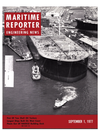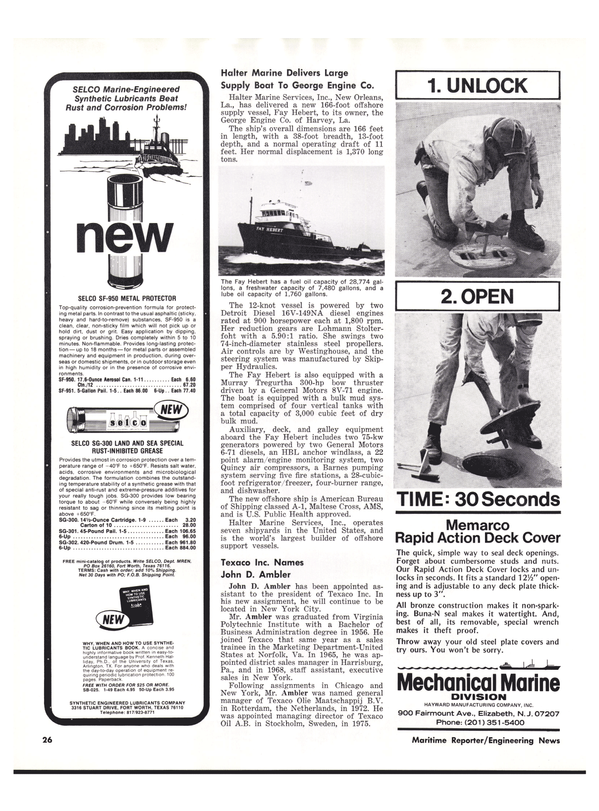
Study Shows Worldwide LNG Production Increase —60 Carriers Needed
Initial projections on the worldwide use of liquid natural gas did not take into account the enormous technical, economic, and logistical hurdles that would arise in the attempt to bring LNG onstream. But now the initial obstacles are being overcome and that—combined with the energy demand in industrialized nations—assures that "a real breakthrough" is now imminent in the worldwide LNG market.
The conclusion, derived from a remarkably rich analysis that covers LNG technology, economics and markets, is documented in a 410-page study, titled "Worldwide LNG Markets," by Frost & Sullivan, Inc. in New York City. Specifically, world- K R U P P IN KRUPP ATL H B M P. O. BOX 58218, HC NAME COMPANY CITY TYPE OF VESSEL(S) wide LNG imports at $758 million this year will increase to $2.35 billion by 1980. But of even greater interest, adds the study, "the stage is set for a very important quantitative rise in LNG shipments to occur between 1980 and 1985." Worldwide imports will soar to $7.9 billion by the end of that period.
To create such worldwide LNG production capacity, industry will make some $17 billion in capital investments over the 10-year period as follows: • Baseload LNG plants: Investments to total $7 billion in 16 equipment categories (controls, valves, heat exchangers, etc.) and three service categories, each analyzed in depth in the two-volume F&S study.
• Storage: Capital investment at $1 billion to boost LNG storage capacity by nearly 10 million tons.
• LNG carriers: A "conservative" forecast shows that some 60 LNG carriers will be necessary as a minimum to meet transportation demands, and this will entail a $9-billion capital investment.
The projections weigh the principal technology alternatives that include 21 different LNG production processes, all principal LNG carrier designs, and LNG production outlook on a country-by-country basis.
The United States, Japan, and Western Europe will continue to rank as the Big 3 LNG consuming areas throughout the decade period, but with the U.S. market that now accounts for 3 percent of the world market to overtake Japan as the biggest single consuming area. Japan currently accounts for 49 percent of the global market.
In absolute terms, U.S. LNG consumption currently at 35,000 tons-a-year (T/y) will increase to 14.5 million T/y in 1980 and "explode" to 60 million T / y by 1985. Japanese LNG imports will also grow, of course, but at a slower rate—from 6 million T/y currently to 16.3 million T/y by 1980 and 40.3 million T /y by 1985. Western Europe imports, meanwhile, at 5.9 million tons in 1977 will increase to 8 million T / y by 1980 and 27.5 million T/y by 1985.
From a production point of view, Algeria will remain the "most important LNG exporter, even after 1985," the study says.
This country alone has some 14 LNG trade commitments that run as long as 25 years, and that will require some 44 additional LNG carriers. Iran is to become the second most important LNG-producing single count r y by the 1980s, even though the country is not yet producing any LNG. Indeed, Iran LNG exports will reach some 21 million T/y by 1985 to be shipped to Japan and the U.S.
To handle the load, Iran will need some 39 additional LNG carriers. Alaska, as the third ranking LNG-producing area, will be exporting some 80 million T/y by 1985, and it will require 15 additional carriers.
The projections, based on orders to materialize by 1980, suggest a 30 percent average annual increase in LNG trade. Fueling the growth is the vast quantity of oil-associated natural gas that is now flared, a desire to eliminate this "frightening waste of natural resource," demand by the industrialized countries for low polluting energy sources, and a worldwide business recovery that will now be able to finance very expensive LNG projects.
For f u r t h e r information, contact Customer Service, Frost & Sullivan, Inc., 106 Fulton Street, New York, N.Y. 10038.
Read Study Shows Worldwide LNG Production Increase —60 Carriers Needed in Pdf, Flash or Html5 edition of September 1977 Maritime Reporter
Other stories from September 1977 issue
Content
- Lloyd's To Class Two Large Crane Barges To Be Built By Mitsui page: 4
- Estimated Foreign Cost Of Two LNG Carriers $115.5 Million Each page: 6
- McAllister Brothers Name Robert Lounsbery Chief Operating Officer page: 7
- Lockheed Wins Contract To Evaluate Ocean Platform Candidates page: 7
- Bethlehem Steel Names G.Y. Marriner Manager San Francisco Yard page: 7
- AMPAC To Build Four Container Feeder Ships At Cost Of $92 Million page: 7
- MarAd Approves Title XI For Five Moran Tugboats page: 8
- SNAME New York Section Announces Program For 1977/1978 Season page: 8
- Willamette Awarded $15 Million To Modernize Alaska State Ferry page: 9
- Marathon Manufacturing Adds $61 Million To Drilling Rig Backlog page: 9
- NASSCO Building 188,500-DWT Tankers For Alaskan Oil Trade page: 10
- Exxon Begins Operating Remote Sea-Floor Production System page: 10
- Propeller Club Convention Includes Shipyard Panel page: 11
- MacMillctn Bloedel Orders Log Carrier At Cost Of $14 Million page: 12
- C-E Names Matthews Manager Of Contracts, Marine Power Systems page: 12
- Role Of Ro/Ro Shipping In Dry Cargo Trade page: 12
- Port Of New Orleans Presents Key To City To Egyptian Official page: 13
- Representatives Meet For First Time In Bahrain page: 14
- Marystown Shipyard Reports On Progress Of $23-Million Norwegian Tugboat Contract page: 14
- Dravo Awarded Two Contracts Totaling $7 Million page: 14
- Morris Guralnick Associates, Inc. Name Hubert E. Russell page: 14
- Canada's Newest Great Lakes Bulk Carrier Launched page: 16
- Todd Seattle Division Lays Keel For Royal Australian Navy Frigate page: 18
- Title XI Approval For Two IOT Subsidiaries page: 18
- Jerry D. Icenhower Named President Glitsch Cryogenics page: 18
- Hillman-Designed New Class Towboat Delivered To Exxon At Baton Rouge page: 19
- BP Invests $50 Million In Stolt-Nielsen page: 20
- Speakers Named For Weather Conference September 14-15-16 page: 22
- $45-Million Subsidy Repayment Approved page: 23
- Study Shows Worldwide LNG Production Increase —60 Carriers Needed page: 24
- Bethlehem Steel Subsidiaries Name Collins And Coulahan page: 25
- Gotaverken Converts Cargo Ship To Carry 32,000 Live Sheep page: 25
- Halter Marine Delivers Large Supply Boat To George Engine Co. page: 26
- Bethlehem Steel Shipbuilding Names Roland V. Danielson —Hollinshead De Luce Retires page: 26
- Perspectives On Third World Port Development page: 30
- APL Names Hubbard Senior VP Operations page: 31
- New National Supply Anchoring Windlass page: 31
- Shallow Water Maneuvering Trials Completed In Gulf page: 32
- Farrell Sale And Leaseback Agreement Approved By MarAd page: 32
- Delta Steamship Names Badger And Collins page: 32
- Gross Tonnage In ABS Classification Exceeds 100-Million Mark page: 33
- Airfilco Appoints Kevin McPherson page: 33
- CCN Of Brazil Launches New Type Bulk Carrier page: 33
- 51st Annual Propeller Club Convention And 1977 American Merchant Marine Conference Set For Galveston, Texas, Oct. 10, 11, 12, 13 And 14 page: 34
- Bulletin Describes Heavy-Duty Oil Filtration Systems page: 35
- Eight-Page Brochure Describes National's Fully Hydraulic Cranes page: 35
- Joseph Hurley Named President ITT Decca Marine page: 36
- Oceangoing Split Hull Self-Propelled Dredge Completes Trials In Gulf page: 37
- ITT Decca Marine Introduces 'Clearscan' New Radar Technique To Reduce Interference page: 38
- Todd Shipyards Los Angeles Division Lays Keel For First Of Six U.S. Navy Frigates page: 38
- MacGregor Slewing Ramps Successfully Tested page: 39
- Skagit Corporation Announces European Dealership Agreement page: 40
- FMC Marine & Rail Lays Keel For Ro/Ro Barge To Carry 374 Forty-Foot Truck Trailers page: 40
- Egyptian Shipyard Receives License To Build Willard Boats page: 42
- Bergeron Industries Names Captain Tatman page: 42
- Port Authorities (AAPA) 66th Annual Convention Set For Mexico City page: 43
- Lloyd's Register Completely Revises Rules For Marine Refrigerated Cargo Installations page: 44
- Tanker Design Change Approved By MSB page: 44
- Navy Contracts For Additional Years Of MARISAT Satellite Service page: 46
- Mitsubishi Receives Tug Barge Systems' License To Build page: 46
- Petro-Marine Names Murray Burns Manager Process Engineering page: 47
- Norshipco Dedicates New $5-Million Repair Pier page: 47
- COMSAT General Expands MARISAT Services To Entire Indian Ocean page: 48
- U.S. Lines Names Three In Operations page: 48
- Fetzner Named President Sun Trading & Marine page: 48
- Philippine Center Exhibit Highlights Filipino Seaman page: 49
- Henschel Announces New Steering-Failure Alarm page: 49
- Tulsa Port Of Catoosa Sets Tonnage Record page: 49
- Jane's Fighting Ships 1977-78 Revised Edition page: 49
- Stanford Research Awarded $271,000 For Firefighting Study page: 50
- Gulf Oil Trading & Transportation Announces Management Changes page: 51
- Renegotiation Board Erred In Computing Lockheed Steel Usage page: 51
- Pott Industries Names Miller VP Offshore Marine Services Div. page: 54
- Joseph R. Burgess To Head Central Pacific Shipping Agency page: 56
- Capt. James F. McNulty New Dean At Maine Maritime Academy page: 56
- Richard Daschbach Named Federal Maritime Commission Chairman page: 57
- Keene Brochure Describes Marine Discharge Control System page: 57
- Heavy Weather Ship Operation Subject Of Webb Seminar page: 58


